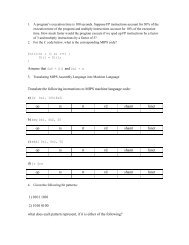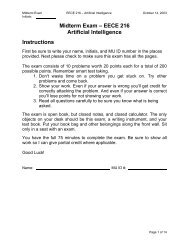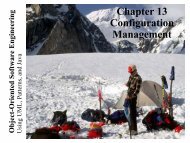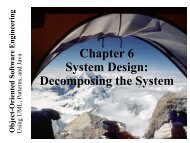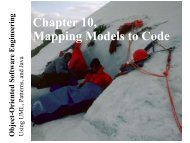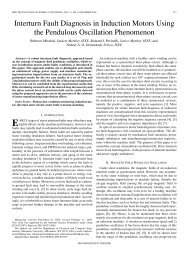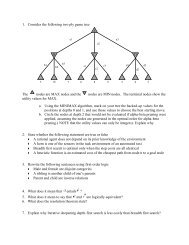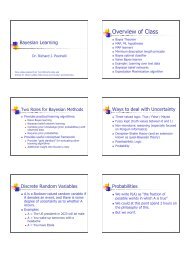A Comparison of Decision Tree Ensemble Creation Techniques Ç
A Comparison of Decision Tree Ensemble Creation Techniques Ç
A Comparison of Decision Tree Ensemble Creation Techniques Ç
Create successful ePaper yourself
Turn your PDF publications into a flip-book with our unique Google optimized e-Paper software.
180 IEEE TRANSACTIONS ON PATTERN ANALYSIS AND MACHINE INTELLIGENCE, VOL. 29, NO. 1, JANUARY 2007been used, and that at this larger ensemble size it does <strong>of</strong>fer someperformance advantage over bagging. However, the increase inaccuracy is statistically significant in only a fraction <strong>of</strong> the data setsused. Random forests-lg and random forests-2 show someimprovement in performance over bagging. The accuracy improvementwith these random forests algorithms is perhaps notquite as big as with boosting-1,000, however they have theadvantage that the trees can be created in parallel.An evaluation approach using the average ranking (by crossvalidationaccuracy) <strong>of</strong> the algorithms on each data set [10] hasrecently been argued to be the best approach for comparing manyalgorithms across many data sets. When we calculated the averageranks and then used the Friedman test followed by the Holm test,boosting 1,000, randomized trees, and random forests werestatistically significantly better than bagging using the 5 2-foldcross-validation accuracies. With the 10-fold cross-validationaccuracies, boosting-50 was also statistically significantly betterthan bagging. We conclude that for any given data set thestatistically significantly better algorithms are likely to be moreaccurate, just not by a significant amount on that data set. So,performance/accuracy trade-<strong>of</strong>fs may make sense in some cases.We also showed a way to automatically determine the size <strong>of</strong> theensemble. The stopping criteria we presented showed that it ispossible to intelligently stop adding classifiers to an ensemble usingout-<strong>of</strong>-bag error, as hypothesized by Breiman. Our experimentsshow this clearly applies to bagging and random forests-lg, whichmakes use <strong>of</strong> bagging. In particular, our results demonstrate that it ispossible to stop much earlier than the minimum out-<strong>of</strong>-bag errorwould dictate, and still achieve good accuracy from the ensemble.The raw accuracy results for the 10-fold and the 5 2-fold crossvalidationsare contained in an appendix. The Appendix can befound at http://computer.org/tpami/archives.htm.[12] R.E. Banfield, L.O. Hall, K.W. Bowyer, and W.P. Kegelmeyer, “A Statistical<strong>Comparison</strong> <strong>of</strong> <strong>Decision</strong> <strong>Tree</strong> <strong>Ensemble</strong> <strong>Creation</strong> <strong>Techniques</strong>,” Proc. 2006Int’l Conf. Systems, Man, and Cybernetics, 2006, to appear.[13] R. Banfield, OpenDT, http://opendt.sourceforge.net/, 2005.[14] J. Quinlan, C4.5: Programs for Machine Learning. Morgan Kaufmann, 1992.[15] I.H. Witten and E. Frank, Data Mining: Practical Machine Learning Tools withJava Implementations. Morgan Kaufmann, 1999.[16] E. Bauer and R. Kohavi, “An Empirical <strong>Comparison</strong> <strong>of</strong> Voting ClassificationAlgorithms: Bagging, Boosting, and Variants,” Machine Learning, vol. 36,nos. 1-2, pp. 105-139, 1999.[17] L. Breiman, “Arcing Classifiers,” Annals <strong>of</strong> Statistics, vol. 26, no. 2, pp. 801-824, 1998.[18] Y. Freund and R. Schapire, “Discussion <strong>of</strong> the Paper ‘Arcing Classifiers’ byLeo Breiman,” Annals <strong>of</strong> Statistics, vol. 26, no. 2, pp. 824-832, 1998.[19] L. Breiman, “Rejoinder to the Paper ‘Arcing Classifiers’ by Leo Breiman,”Annals <strong>of</strong> Statistics, vol. 26, no. 2, pp. 841-849, 1998.[20] R.E. Banfield, L.O. Hall, K.W. Bowyer, and W.P. Kegelmeyer, “A New<strong>Ensemble</strong> Diversity Measure Applied to Thinning <strong>Ensemble</strong>s,” Proc. FifthInt’l Workshop Multiple Classifier Systems, pp. 306-316, 2003.[21] C. Merz and P. Murphy, UCI Repository <strong>of</strong> Machine Learning Databases, Dept.<strong>of</strong> CIS, Univ. <strong>of</strong> California, Irvine, http://www.ics.uci.edu/~mlearn/MLRepository.html, 2006.[22] R.E. Schapire, Y. Freund, P. Bartlett, and W.S. Lee, “Boosting the Margin: ANew Explanation for the Effectiveness <strong>of</strong> Voting Methods,” Proc. 14th Int’lConf. Machine Learning, pp. 322-330, 1997.[23] R. Johnson and D. Wichern, Applied Multivariate Statistical Analysis, third ed.Prentice-Hall, 1992.. For more information on this or any other computing topic, please visit ourDigital Library at www.computer.org/publications/dlib.ACKNOWLEDGMENTSThis research was partially supported by the US Department <strong>of</strong>Energy through the ASCI (DVS) Data Discovery Program,Contract number: DE-AC04-76DO00789 and the US NationalScience Foundation under grant EIA-0130768. The authors wouldlike to thank Remy Losaria for her help with the 5 2-fold crossvalidationexperiments.REFERENCES[1] L. Breiman, “Bagging Predictors,” Machine Learning, vol. 24, pp. 123-140,1996.[2] G. Eibl and K. Pfeiffer, “How to Make AdaBoost.M1 Work for Weak BaseClassifiers by Changing Only One Line <strong>of</strong> the Code,” Proc. 13th EuropeanConf. Machine Learning, pp. 72-83, 2002.[3] Y. Freund and R. Schapire, “Experiments with a New Boosting Algorithm,”Proc. 13th Nat’l Conf. Machine Learning, pp. 148-156, 1996.[4] R. Schapire, “The Strength <strong>of</strong> Weak Learnability,” Machine Learning, vol. 5,no. 2, pp. 197-227, 1990.[5] T. Ho, “The Random Subspace Method for Constructing <strong>Decision</strong> Forests,”IEEE Trans. Pattern Analysis and Machine Intelligence, vol. 20, no. 8, pp. 832-844, Aug. 1998.[6] L. Breiman, “Random Forests,” Machine Learning, vol. 45, no. 1, pp. 5-32,2001.[7] T. Dietterich, “An Experimental <strong>Comparison</strong> <strong>of</strong> Three Methods forConstructing <strong>Ensemble</strong>s <strong>of</strong> <strong>Decision</strong> <strong>Tree</strong>s: Bagging, Boosting, andRandomization,” Machine Learning, vol. 40, no. 2, pp. 139-157, 2000.[8] T.G. Dietterich, “Approximate Statistical Test for Comparing SupervisedClassification Learning Algorithms,” Neural Computation, vol. 10, no. 7,pp. 1895-1923, 1998.[9] E. Alpaydin, “Combined 5 2 cv F Test for Comparing SupervisedClassification Learning Algorithms,” Neural Computation, vol. 11, no. 8,pp. 1885-1892, 1999.[10] J. Demsar, “Statistical <strong>Comparison</strong>s <strong>of</strong> Classifiers over Multiple Data Sets,”J. Machine Learning Research, vol. 7, pp. 1-30, 2006.[11] L. Hall, K. Bowyer, R. Banfield, D. Bhadoria, W. Kegelmeyer, and S.Eschrich, “Comparing Pure Parallel <strong>Ensemble</strong> <strong>Creation</strong> <strong>Techniques</strong> againstBagging,” Proc. Third IEEE Int’l Conf. Data Mining, pp. 533-536, 2003.




